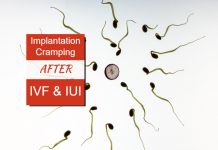Implantation bleeding is the first sign of pregnancy. Most women miss it thinking it to be random spotting. Implantation bleeding is the earliest way to detect pregnancy. If you are trying to get pregnant, then you must read this to know about the characteristics of implantation bleeding.
Spotting after ovulation happens when the period has to start. But this happens when you are near to your period. Post ovulation bleeding before a week from the due period is frightening for those who did not know about implantation bleeding.
Women who want to get pregnant get a shocker when they see blood coming from the vagina. Any woman doesn’t take bleeding from vagina lightly except during period. Do they take it lightly even then! Implantation bleeding is less commonly known and experienced phenomenon.

15 Characteristics Of Implantation Bleeding
You need to know about the characteristics of implantation bleeding if you want to distinguish it. Everywhere you’ll find a few characters to distinguish the two. But there are major 15 characteristics of implantation bleeding to differentiate from the period. You can observe these, to diagnose implantation bleeding yourself.
1) Time of implantation bleeding
Implantation bleeding occurs two weeks before a missed period. You can time this from ovulating date too. In that case, implantation bleeding occurs after a week from ovulation. It is like an event that happens between period and ovulation to divert the path to pregnancy. After fertilization, the egg cleavage begins, and it moves down the tube. It takes three days for the egg to divide four times. After a week the egg attaches to the wall of the uterus and slowly moves in the lining.
2) Color of implantation bleeding
Implantation bleeding, unlike the period, is brown. The bleeding only lasts for few minutes, and the blood cannot flow out in such a short span of time. So it stays there in the vagina, and the clotting factors make it old. Later on, as there is spotting the blood is brown. Due to mixing with cervical mucus it can look orange. In case you have bright blood coming from vagina then you are having an actively bleeding area in your womb.
3) Intensity of implantation bleeding
The intensity of bleeding refers to the continuity of flow. During the first two days of the period, you have phases of continuous blood flow. But implantation bleeding never happens incessantly. It will always be like random bleeding. The bleeding intensity is so low that it is like spotting. Only a few drops of blood come out of the vagina during implantation.
4) Duration of spotting during implantation
Implantation bleeding lasts for about a day or two. This is because a small structure can only lead to a very low amount of bleeding. Compared to it the duration of bleeding during period and miscarriage is 5-10 ten times more. The period lasts for about five days while miscarriage leads to heavy bleeding for a week or more.
5) Kind of post ovulation spotting
There are no clots in implantation bleeding. The amount of blood is very less amounting to a few drops. The kind of discharge during implantation is more of spotting and least like bleeding. There may be mixing with cervical mucus to cause a pink tinge. Any other actively bleeding area in uterus gives bright red blood. There are clots of the disintegrated wall of uterus lining during menses.
6) Pain
Implantation pain is not an agonizing event. You might feel slight discomfort, and that will be the most that could happen. During implantation spotting, one doesn’t feel any sharp pain. Period pain is more than half of the problem during a month. Miscarriage or tubal pregnancy also have extreme cramping pain associated with it. The occurrence of excruciating pain in itself is a sign that it is not implantation.
7) Cramping
During implantation, the cramps are more like tingling sensations. PMS cramps or period cramps are unbearable. Some women need to take a painkiller or muscle relaxant during period cramping. Implantation cramps don’t require such analgesics.
8) Amount
The amount of blood released during implantation is only a few drops. Any woman who soaks a pad within an hour is surely not having implantation. During menses, there is a heavy flow of blood, and it continues for days. The reason behind excessive blood flow is that the entire uterine lining comes off.
9) Symptoms
Implantation symptoms are few and mild. There may be implantation bleeding, or it is even possible to have a healthy pregnancy without it. During implantation, there is bloating near the abdomen and breasts changes. All the hormonal changes cause early pregnancy symptoms. Pregnancy toxicosis causes morning sickness like symptoms. Period symptoms are most painful and related to the vaginal muscles.
10) Positive Pregnancy Test
After a week from implantation, one must get a positive pregnancy test. This is because the placenta starts forming as soon as implantation is complete. Later on, the production of hCG begins. This is the hormone that pregnancy tests detect and so you get a positive pregnancy test after implantation. The hCG levels start doubling after every two days or 48 hours.
11) Basal body temperature
During implantation, there is an ambiguous dip in BBT. This happens in the case of non-pregnant women too but is more common during pregnancy. So there is a term for it called ‘implantation dip.’ The rise of BBT during ovulation, followed by fall during implantation and restoration to normal range forms a triphasic pattern. This is a sign of pregnancy if accurately measured.
12) Mucus changes
After implantation, the cyst keeps releasing progesterone. This hormone is a pregnancy hormone and prevents menses. It also enhances the production of thick white cervical mucus to form a mucus plug. In other cases when you have menses or miscarriage, your cervical mucus won’t increase after bleeding. After the period there is a phase of dry days where the amount of cervical mucus is negligible.
13) Prevalence
Implantation bleeding occurs for only 33% of pregnant women. Period happens whether regularly or not in case of every fertile woman after puberty. Thus implantation bleeding is a less prevalent phenomenon.
14) Risks
There is no risk in case of light implantation bleeding. If there is heavy implantation bleeding, then you may have a chemical pregnancy. It is a miscarriage due to the rejection of embryo or any such event. There is also a possibility that you had implantation at the wrong site.
15) After implantation bleeding
Early pregnancy symptoms start after implantation spotting. Morning sickness might not be evident until a week after it. Nasal congestion and frequent urge to urinate are common early pregnancy signs. Later on, you might even have leg cramps and bloating.
When to expect implantation spotting?
Normal implantation happens after 7-10 days from ovulation. If implantation occurs in less than 7 days after ovulation, then it is early egg embedment.
More than ten days for implantation comes under the category of late egg embedment. If there is late implantation, then you might even have it during menses. And in that case, you will miss your period next month.
If you solely rely on the absence of period as a sign of pregnancy, then you’ll continue with a cryptic pregnancy. On an average, most women undergo implantation by the 10th-day post ovulation. Some might have it earlier buy the late egg embedment is a more rare occurrence.




![Implantation Bleeding With Twins [How long does IB last with twins?] Implantation Bleeding With Twins](https://www.pregnanteve.com/wp-content/uploads/2019/01/implantation-bleeding-with-twins-218x150.jpg)




